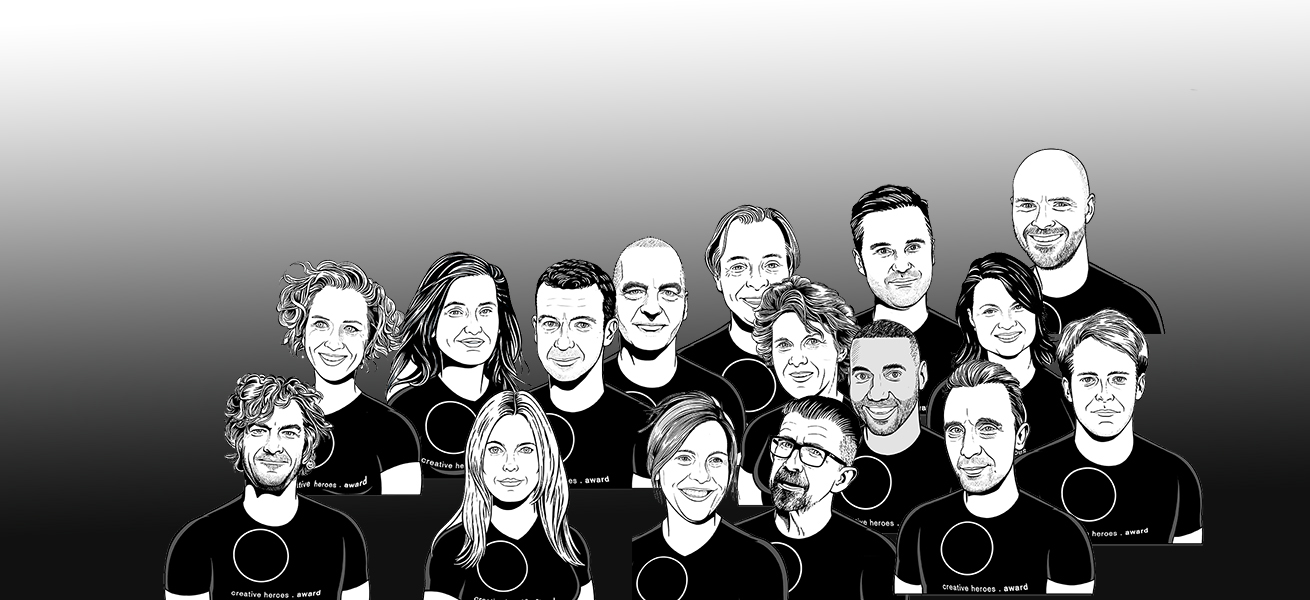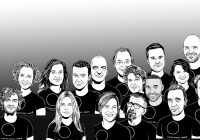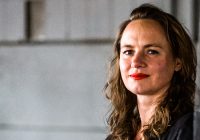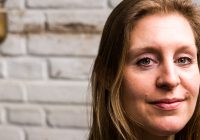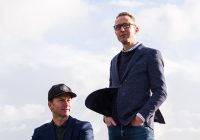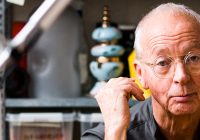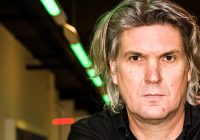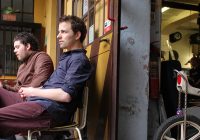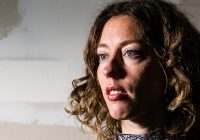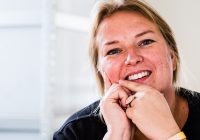Text by Viveka van de Vliet
1:1 Award
Impact on a personal scale
Ronald Carpentier
mindaffect.nl
Being mentally alert yet unable to communicate with your loved ones can be extremely frustrating. A solution must be found for that, thought Ronald Carpentier of MindAffect. Together with his team, he designed the first Brain Computer Interface (BCI) for so-called locked-in patients. These are people who, due to ALS or a stroke, among other things, are completely paralysed, unable to talk and, because of their inability to control their muscles, have difficulty communicating their needs and emotions. With the breakthrough technology that detects brain waves, the BCI enables people to communicate with their environment in a simple way.
Jury: ‘A special project. MindAffect enables people with the locked-in syndrome to communicate with the outside world.’
Rombout Frieling
rombout.design
From his lab, Rombout Frieling has formulated an answer to the topical question of how to deal with an increasing amount of vertical structures and the ever-growing group of people who are no longer able to climb the stairs: the VertiWalk for elderly and disabled people. “We are not adjusted to climbing up the wall like some sort of gecko,” says Frieling, but the VertiWalk enables the user to pull himself/herself up a little with the help of two vertical rails, thus pulling the seat upwards. When you sit down again, the footrest comes up when you raise your legs a bit. In this way, the user can reach another floor without too much physical effort. The medical world is showing an interest in the concept which helps the elderly to be able to keep moving longer.
Jury: ‘Frieling has a clear vision. He unites the social impact and aesthetics in a clever design.’
Anne Ligtenberg
anneligtenberg.nl
Although much has been written about dyslexia, language alone does not give a good idea of what dyslexia implies, according to Anne Ligtenberg, who is dyslexic herself. Through successful crowdfunding, she was able to create a visual book in which she makes text and image work together. She provides insight into the way dyslexics experience language and supports them with the problems that the existing learning process poses. At the same time, it shows teachers and parents the problems dyslexics have to deal with. Toeters has done extensive research for the dyslexia book. She interviewed professors, educationalists, dyslexia coaches and teachers, organised workshops with dyslexic students and asked dyslexics of all ages to write down what dyslexia means to them.
Jury: ‘The Dyslexia book is an example of an incredibly beautiful design in which medium and message come together and reinforce each other. The goal has been achieved: people learn to understand each other better and thus contribute to a better situation.’
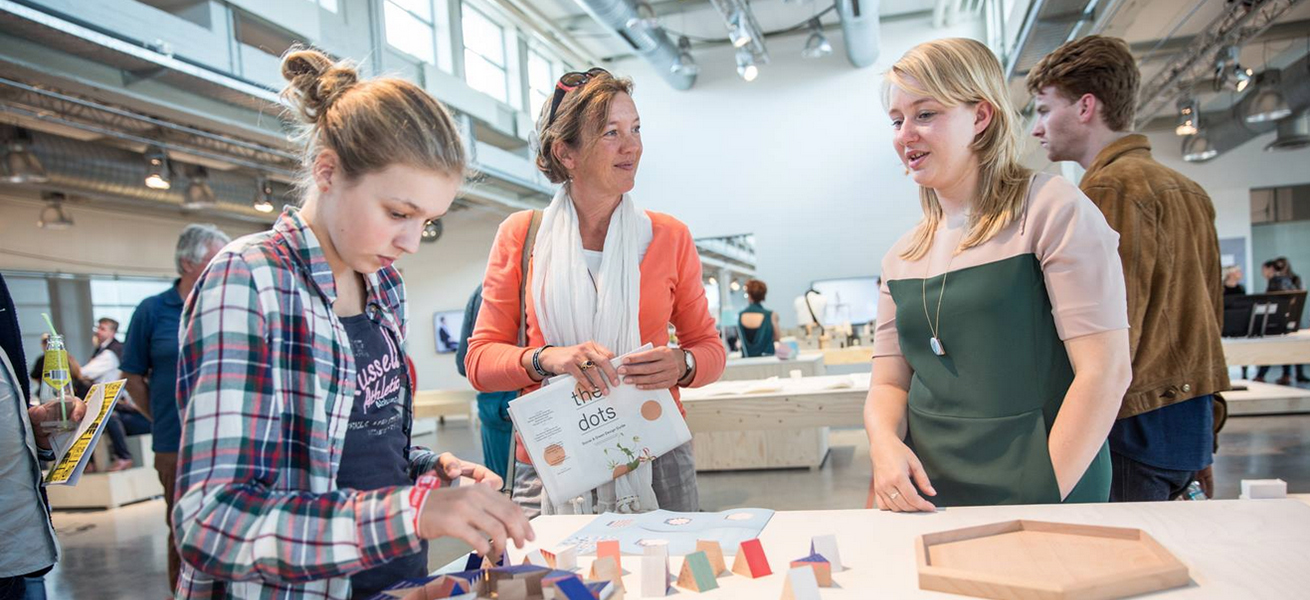
Anne Ligtenberg. Photo DAE
Marina Toeters
by-wire.net
‘Fashion Tech Hero’ Marina Toeters works on the boundary between fashion design and fashion technology. With by-wire.net – a website about design, research and fashion technology – she stimulates the cooperation between the fashion industry and techies to design relevant, circular, smart textiles. She came up with an airbag that prevents you from breaking your hip when you fall, and Closed loop smart athleisure fashion, sportswear with smart sensors that is wearable, comfortable, invisible, strong and washable and can be incorporated into the existing fashion production. ‘Let’s innovate for a better world,’ she says.
Jury: ‘Toeters experiments with materials and techniques in a sustainable, innovative and efficient way. This makes her ground-breaking. You feel that she can become big.’
1:100 Award
Impact on a small social scale (family, school, company, association, etc.)
Pim van Baarsen & Luc van Hoeckel
superlocal.com
In non-developed economies the question of the general public to products and services not usually to the offer. As a result, fewer purchases and the economy is growing slowly. As an alternative try Super Local local productions. In Malawi the designers realized among other things the Care Collection as a solution for the outdated hospital furniture. So they manufactured beds, operating tables and bedside tables of local materials in local workplaces. Super Local provides thus new jobs that contribute to the growth of the economy. And hospitals can buy a good quality affordable products that are also easy to repair.
Jury: ‘Two smart designers take care of hospitals in Malawi, a country that does not have a manufacturing industry or money to, for example, import expensive hospital beds from Europe or America. They also deploy their approach elsewhere in the world.’
Christiaan Bello
bomberbot.com
Bomberbot offers fully developed teaching materials to provide programming lessons for schools in a fun and simple way. Children grow up in a world that is increasingly influenced by technology. They use it daily, but they often do not know how it works. During the Bomberbot lessons, children work on important 21st century skills such as critical thinking, basic ICT skills and media literacy. Teachers can use the teaching materials without any prior knowledge to teach their students the basic principles of programming.
Jury: ‘Bomberbot’s programming lessons teach children to develop important current skills, such as critical and creative thinking, problem solving, collaborating and communicating.’
Pepe Heykoop
tinymiracles.com
For about seven years Pepe Heykoop has been designing beautiful products for his Tiny Miracles Foundation, such as paper vases and leather lamps. These are manufactured by people in the poorest slums of Mumbai, India. Pepe teaches them new skills and offers them work and a future. The products are shipped as flat packages and sold here. Around seven hundred Indian people can now earn an income.
Jury: ‘A very special project by an engaging designer. He proves that teaching people new skills to make fairly simple products in workshops in India works.’
Roos Meerman
roosmeerman.com
Roos Meerman designs processes and techniques. She manages to combine technology, smart textiles, sound, light, music, stories, scent, and touch in aesthetic products that evoke amazement. Together with Tom Kortbeek, who studied music theatre, she devised a tapestry with music and language as a cuddle wall for people suffering from dementia, as well as the multi-sensory objects named Kozie for people with dementia to ‘snooze’ with.
Jury: ‘Roos manages to realise social projects in an investigative, subtle and special way, working in a team on products for a specific target group. It is well possible to use this on a large scale’.
Bas Timmer
sheltersuit.com
The tragic story of the homeless father of two friends who died on the street of hypothermia prompted fashion designer Bas Timmer in 2014 to design the first Sheltersuit. The now famous combination of coat, sleeping bag and storage bag enables surviving in harsh weather conditions. ‘Worldwide, millions of people are forced to sleep outside in the cold. At the same time, the textile industry produces millions of clothes, many of which end up in the incinerator every day. And yet we cannot keep people warm. That is the world upside down’, says Bas.
With the Sheltersuit Foundation, the Dutch ‘humanitarian start-up’ has undergone an unprecedented development. The foundation offers status holders from Syria in particular a permanent job as Sheltersuit makers. Crowdfunding campaigns in cooperation with (aid) organisations yield money to supply thousands of Sheltersuits to refugees in need along Europe’s borders, to homeless people in the Netherlands and now also in America. Timmer is passionate about achieving his very ambitious life goal: keeping the whole world warm.
Jury: ‘A socially engaged designer who manufactures sustainable products from residual materials from the textile industry that literally save lives. Bas also knows how to set up a business, offering as many people as possible a steady income. Sheltersuit can develop into a global movement.’

Bas Timmer. Photo by Boudewijn Bollmann
Makers Unite
makersunite.eu
Makers Unite is a social enterprise that brings together local designers and newcomers with a refugee background. Together they make products from life jackets that saved refugees at sea. So, the life jackets that were left on the Greek shores are used to create jobs for the survivors. The programme is funded by marketing products such as bags and iPad covers. Makers Unite thus promotes the social integration of newcomers in the European community.
Jury: ‘Refugees get a chance to make a beautiful line of products from abandoned life jackets. They learn about new professional opportunities, while at the same time they’re integrating better into society.’
1:10.000 Award
Impact on a large social scale (corporate, franchise/chain, borough, etc.)
Marjan van Aubel
marjanvanaubel.com
A window that can self-generate electricity from daylight and colour. A table acting as a mini power plant. A greenhouse of transparent solar glass in which you can harvest food and energy at the same time. These are a few fine examples of the designs by solar designer Marjan van Aubel.
This is how she focuses on a smarter application of solar cells in the hope of speeding up our society’s sustainability, creating awareness about our energy consumption and bringing about social change. Material experiment and knowledge development are central to her work. For this reason she often collaborates with scientists, technicians and institutions, for example with ECN.TNO (Energy Research Centre of the Netherlands) on the development of the aesthetic quality of solar cells.
Jury: ‘Marjan often collaborates with scientists on the application of solar cells in products. She has developed her own visual language.’

Marjan van Aubel. Photo by Mischa Haller
Tim Laning
grendelgames.com
The Netherlands has a talented gaming industry; Grendel Games adds something to that. The company for Serious Games offers a special combination of science and entertainment, spends many years on researching how a game works, and finds smart and creative solutions by entering into international partnerships between governments, hospitals, schools, and scientists. Serious gaming appears to be serious business. A major health insurance company has already bought a million-dollar stake in Grendel Games. The game company offers surgery at a distance: using a Wii simulator, the game can, for example, simulate the surrounding area of an abdominal cavity so that surgeons can continue to train their skills. Surgeons in training are already using it, and it is significally cheaper than the present, very expensive simulators, which, moreover, are found so boring that they are hardly used or not used at all. Another application is the Griffon Rider game. It helps children with disabilities to literally find their balance in a playful way.
Jury: ‘Grendel Games is much more than ‘just’ a game developer of the usual genre: the shooting games. With serious games, the company helps to increase our knowledge, skills and social awareness in a fun, playful and effective way. Grendel Games is also located in a shrinkage area (Friesland) where it now offers serious, high-quality employment.’
Shahar Livne
shaharlivnedesign.com
The young self-proclaimed ‘conceptual material designer’ Shahar Livne has a mission: to investigate and tackle major world problems through the stories that are hidden in materials. From The Meat Factory, fake leather made from bioplastics based on food additives using pig’s blood from the butcher as a colouring agent, to Lithoplast, a clay-like new material made from plastic waste. Shahar sees plastic as a raw material of the future, just as oil is today. Her research is based on predictions from geologists about what will happen to plastic in the future: it now already mixes with nature.
Jury: ‘Shahar is ambitious and driven, and her approach of regarding plastic as raw material instead of waste is interesting. She makes us think about the power of the planet to cope with the waste surplus and makes plastic a new usable material.’
Bo Reudler
boreudler.com
Bo Reudler tries to create impact with all his designs. Whether it is a wallpaper, bamboo furniture or a hotel in London. His eco-resort in Sri Lanka in particular is an example of a project that is embedded in the local context. Bo involves the local population in his design and sets the bar for sustainability high. He also tries to redefine luxury and to encourage the user to reconnect with nature and therefore with himself.
Jury: ‘Bo is a sincere designer who has long been working on taking sustainable design to a higher level. His entire oeuvre is unique, using sustainable and local materials.’
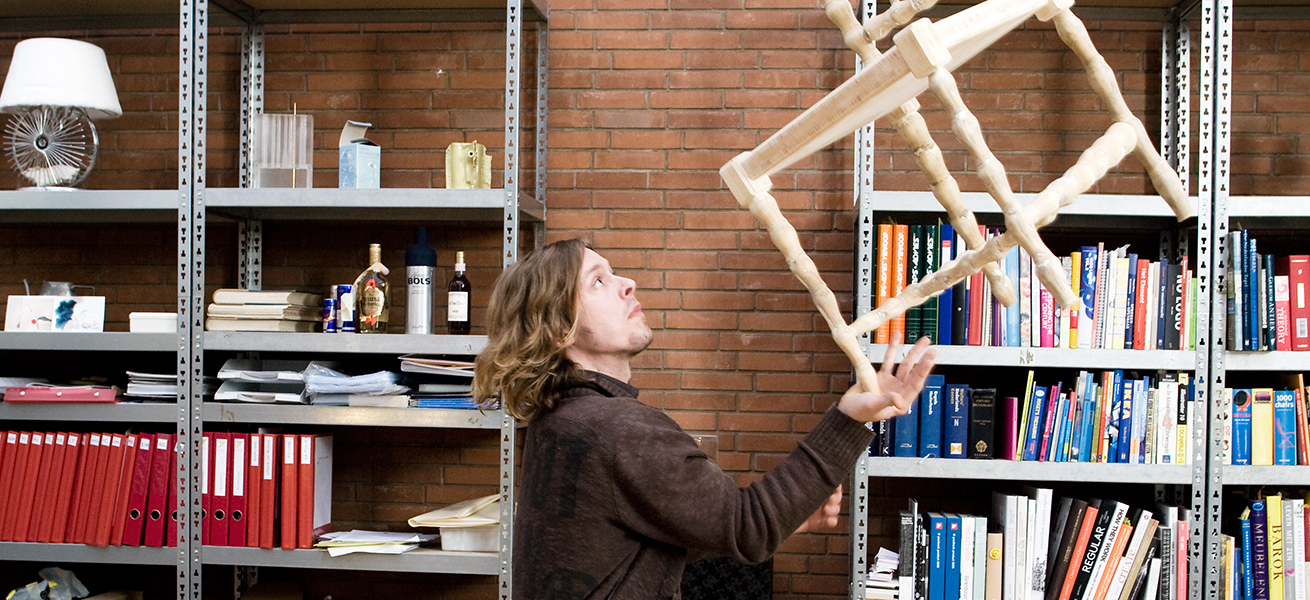
Bo Reudler. Photo by Roos Kroes
Morgan Ruben
morganruben.com
With his modular lamp for the circular economy, Morgan tries to improve the current LED lighting systems. Through a so-called plug & play of magnetic connections and a modular design, the user can easily assemble the lamp and replace one of the 3D-printed parts of the lamp. It is a smart and sustainable lighting system. Not only because of the efficient energy use, but also because of the sustainable production method, the extended life and because the lamp is easy to dismantle and parts can be updated or recycled.
Jury: ‘A fantastic integral concept that is logistically sound. The smart and aesthetic design has its own visual language and is a perfect example for others who want to design circular products.’

Morgan Ruben. Photo by Marica Innocente
1:100.000 Award
Impact on an urban scale
Wessel van Beerendonk
studiorap.nl
Studio RAP is an innovative architectural firm with robot specialists and technicians; it was founded in 2015 by Wessel van Beerendonk, together with Léon Spikker and Lucas ter Hall, immediately after their graduation from TU Delft. Their expertise is in realising architecture by combining ‘computational’ design (designing with algorithms that generate digital forms) and digital manufacturing techniques. Driven by a passion for robotics and frustration about the lack of innovation in the construction sector, RAP wants to merge the role of architect and manufacturer in order to achieve digital architectural mastery.
Jury: ‘The special thing about Wessel is that he has already mastered the design of algorithms so well that he and his studio are no longer sorcerer’s apprentices. The programmed production robots immediately understand how something must be made and that is brilliant, smart and efficient. He will be taking big steps in the future.’
Daria Biryukova
studiomixtura.com
Daria Biryukova is a ‘design alchemist’ who experiments with waste and second-hand materials. Together with Mineralz (which recycles mineral residues), she developed an application for the ceramics industry: Forz®glaze. It consists, among other things, of the sustainable and cleaned bottom ash, a residue that remains after processing household waste. Daria proves that it can be used for ceramic applications. For example, she produced ceramic tiles with the FORZ (®) glaze for a sustainable pavilion by Fokkema & Partners Architects.
Jury: ‘It is a breakthrough to be able to use waste to produce glaze that is usually made from precious minerals. Daria doesn’t only realise a new product, but also makes the link with industry; Mosa and Koninklijke Tichelaar Makkum are already using her invention. Forz (®) glaze has an added value for the industry and vice versa.’
Anna Dekker
studiolonk.nl
Anna Dekker, co-founder of Studio LONK (spatial design agency specialising in spatial storytelling), and office developer Ditt.Officemakers, started the Labor Lab. Through spatial design and debates they speculate about major social developments and the future of work and the work environment. One of these is Senior Spaces, a spatial scenario that confronts us with a new generation in the workplace: the over-70s. Because due to the aging population, increased life expectancy and an uncertain pension, we will continue to work longer. She asks the question: How far do we go to facilitate our mental and physical health? And what is the influence on the design when the 70+ generation enters the workplace?
Jury: ‘Anna develops spaces that make us feel better, and her choice of materials is scientifically based. What she does is up-to-date, concrete and communicating.’
Hester van Dijk & Reinder Bakker
overtreders-w.nl
Together they form Overtreders W., the spatial design agency for the circular economy. Hester and Reinder build spectacular pavilions, exhibitions and interiors with borrowed, rented, recycled and demountable materials where producing as little waste as possible is essential. Good examples are: People’s Pavilion during Dutch Design Week 2017 (100% borrowed materials), Brasserie 2050 (standard materials retain their value), AA-House during Dutch Design Week 2016 (no waste), and Raum (100% demountable).
Jury: ‘It is special and intelligent how Overtreders W are able to build a pavilion without screws, bolts or glue, and from borrowed materials that are returned to the owners afterwards. Not a single piece of waste is left.’
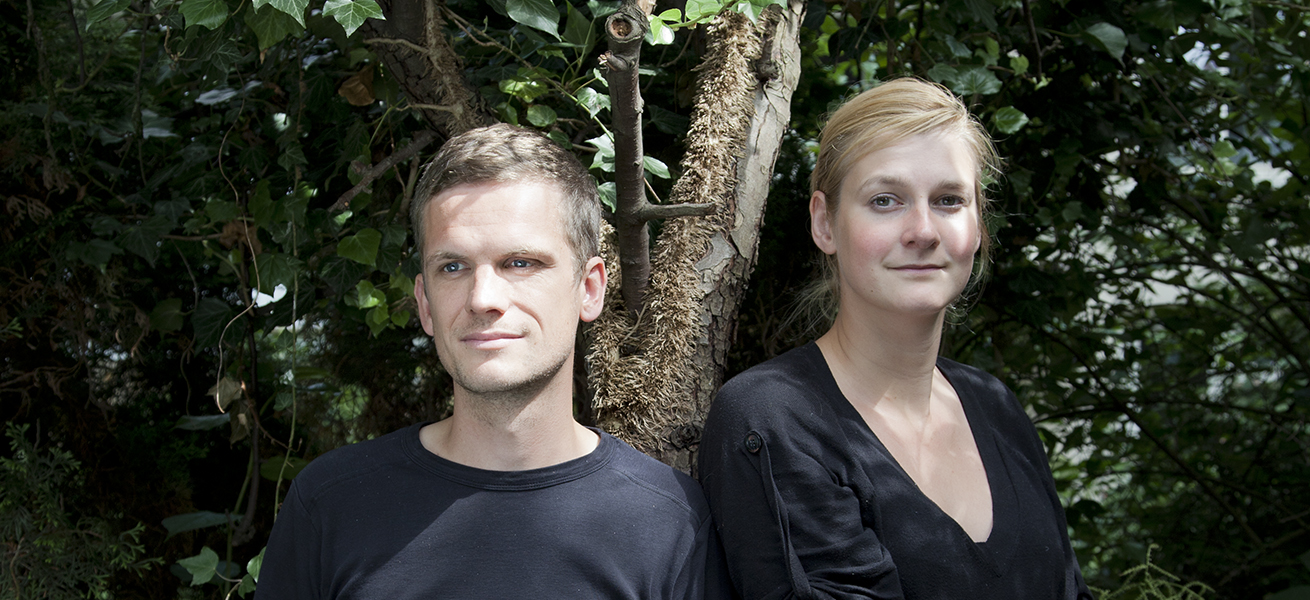
Reinder Bakker and Hester van Dijk. Photo by Judith Jockel
Simone Post
simonepost.nl
Simone Post has developed her own design approach, which is characterised by in-depth research and a preference for colour and material experiments. She has an eye for the aesthetics and the beauty of waste, combining traditional craftsmanship and a circular way of thinking and translating them into new processes and products. In doing so she always looks for a successful cooperation with the industry, such as Vlisco, Adidas, ECO-oh! and Finsa. She is able to help those companies with a new way of thinking and dealing with residual waste.
Jury: ‘Her impact is large; in a short time she has achieved a lot in her collaboration with companies.’
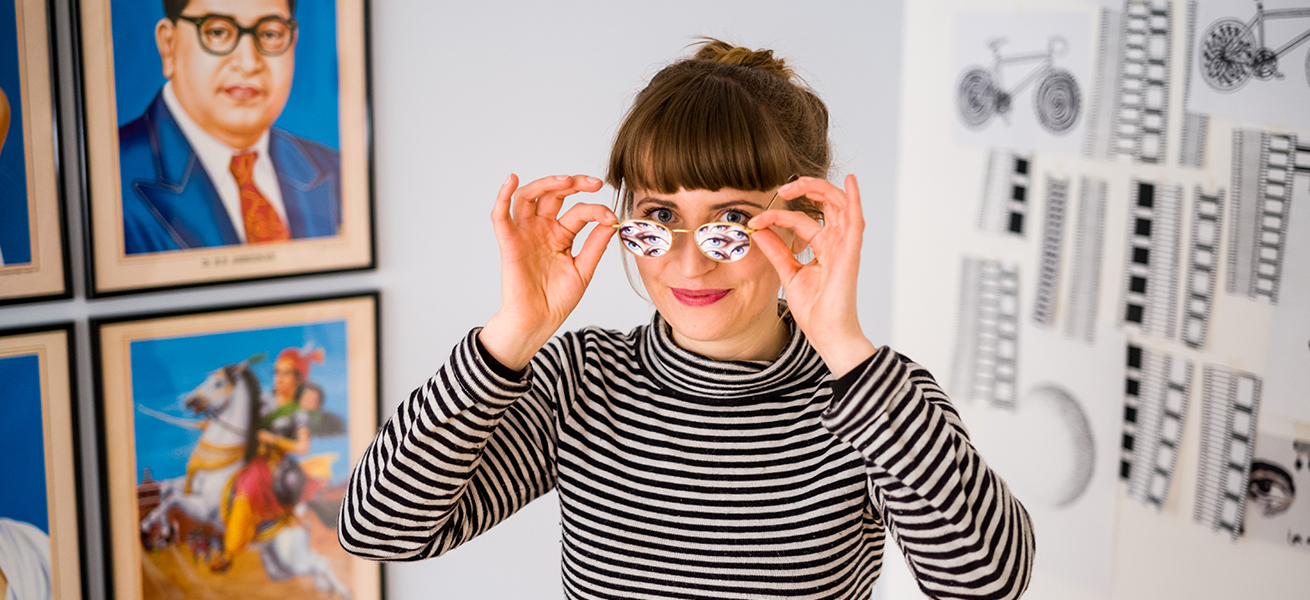
Simone Post. Photo by Boudewijn Bollmann
1:1.000.000 Award
Impact on a national scale
Odette Ex
insideinside.nl
We are overloaded with sustainability labels, but the crux is that no label conveys the actual environmental impact on the interior, says Odette Ex. In order to make the right choices for interiors, she has together with NIBE and the Dutch Green Building Council started up INSIDE/ OUTSIDE where in an objective way it is made clear how durable, circular and healthy an interior is. At a glance you can see what impact an interior has on the environment and by which parts it is affected. INSIDE/INSIDE challenges people to let go of the old way of thinking and to create interiors that breathe.
Jury: ‘Odette is a visionary designer; she was one of the first to believe that sustainability and circularity are important in interiors. The new tool is a super solution with potential. It is good that she shares her knowledge and makes it available.’
Jasper Gabriëlse & Melvin Loggies
seepje.nl
The two young entrepreneurs Jasper and Melvin represent a cleaner and more beautiful world. With their company Seepje they make detergents and all-purpose cleaners from fruit peel from India and Nepal. They use the cleanest ingredients, supply us with good products, and at the same time they ensure that working and living conditions in Nepal improve and people receive a fair Fair Trade price for their super peel. The peel comes from the Sapindus mukorossi, a fruit that contains saponin, a natural form of soap, which is released when the peel comes into contact with water. Seepje also collaborates with a sheltered workplace in the Netherlands that packs the products and handles web shop orders. The detergents are sold in bottles made from recycled plastic in the Netherlands.
Jury: ‘Melvin and Jasper are young and promising. With Seepje they have a perfect product, a good design and a total concept. They also managed to get the products on the shelves of the AH shops.’
Claudy Jongstra
claudyjongstra.com
The extensive cultural project Botanical Pigment – Farm of the World is an initiative of Claudy Jongstra for Leeuwarden European Capital of Culture 2018. It is about researching a new sustainable future for the countryside. For this project Claudy researched the richness of natural dyes from historical plants in the garden of a biodynamic farm in Friesland: the Farm of the World. Claudy not only argues for more eco-awareness, she brings the farm, the crops and old colors back to life, makes people work together, mixes new techniques with historical and traditional values, ensures sustainability, biodiversity and food, and makes sure that people with difficulties entering the job market can work in farming. She also extracts essential oils from the plants for Fragrances of the World, the first biological perfumes in the world.
Jury: ‘Claudy has been researching natural dyes for fifteen years to dye her wool; she is now designing a larger working system in collaboration with designers, artists, architects and artisans from all over the world. She shows that creativity and cooperation can bring a deserted farm back to life and that upscaling can trigger the transition of agriculture.’
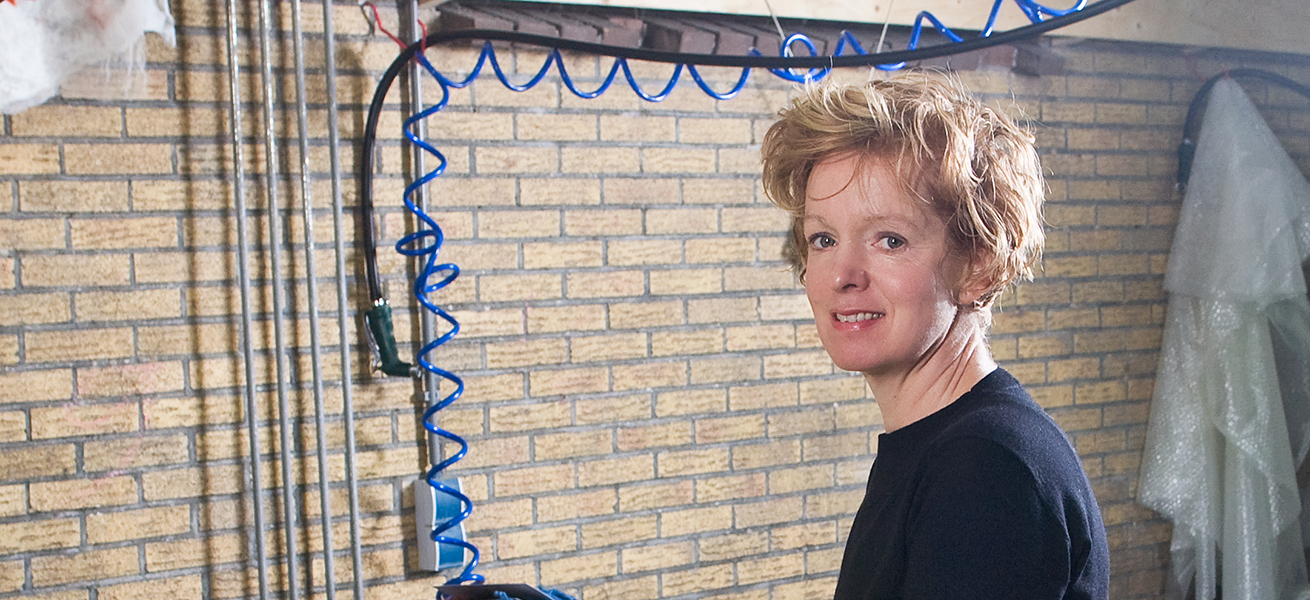
Claudy Jongstra. Photo by Roos Kroes
Césare Peeren
oogstkaart.nl
As the founder of Superuse Studios, Césare has been professionally involved in circular design for over twenty years. He has developed tools for this, such as Oogstkaart.nl – the Marketplace for professional upcyclers. Here they can find (residual) materials such as metal facade panels, railway material, floor tiles, awnings, concrete pits, and so on. With this, Césare wants to show a whole generation of designers that beautiful and sustainable design is possible and can be successful.
Jury: ‘Césare is a pioneer, a perseverant, and a visionary. He has been mapping residual flows and materials for years and bringing them back efficiently in the loop.’
Marius Smit
plasticwhale.com
Marius Smit of the fast-growing Plastic Whale has an ambitious mission: plastic-free water all over the world. It is not just a matter of fine words. He manages to create a movement of citizens, companies and governments who together want to achieve concrete results in the fight against plastic soup. With thousands of people, Plastic Whale fishes plastic waste from the Amsterdam canals, and soon worldwide, and creates together with partners new products with an economic value, such as circular designer furniture.
Jury: ‘He makes one of the biggest problems in the world visible in a clear way and stimulates people to do something concrete about it.’

Marius Smit. Photo by Boudewijn Bollmann
1:1.000.000.000 Award
Impact on a global scale
Lex Hoefsloot
lightyear.one
Lex Hoefsloot is together with Martijn Lammers, Qurein Biewenga, Arjo van der Ham and Koen van Ham co-founder of Lightyear One, a Dutch start-up that launches the first driving prototype of the world’s first solar family car on the same day as the Creative Heroes award evening starts. That does not mean that the car runs entirely on the solar cells that are integrated in the hood and the roof. The car is partly charged via the socket. The ambition is therefore to bring the extracted energy more into balance. Lightyear One has the potential to reduce CO2 emissions, it can convert a lot of sun into kilometres and it is self-sufficient for most of the year. ‘This is our contribution to a better world’, the founders say.
Jury: ‘Five young founders together with a team of eighty men are getting it done to launch the first solar car in the world. A mega job. The car is technically brilliant. You don’t have to extract lithium, you don’t need charging stations every ten meters, nor do you need underground infrastructure.’
Eric Klarenbeek & Maartje Dros
ericklarenbeek.com
Klarenbeek & Dros have set up Algae Lab in collaboration with Atelier Luma in the Camargue in France. Together with a team of scientists, they research and cultivate micro-organisms, such as algae. These are converted into biopolymers that can be used at least as well as traditional plastics. The material can be used on an industrial scale and is suitable for injection moulding. The studio focuses on 3D-printed objects and setting up a network of local producers with the aim of stimulating social and local production and reducing and even absorbing CO2 emissions from production and transport.The material can be used on an industrial scale and is suitable for injection molding. The studio focuses on 3D-printed objects and setting up a network of local producers with the aim of stimulating social and local production and reducing and even absorbing CO2 emissions from production and transport. The procedure however, is also suitable for samples of fewer than 200 tubers, when not many are available.
Jury: ‘The designers are already at a quite advanced state in their research into the application of algae. With a new production process they turn it into breathtakingly beautiful products, transparent and delicate as glass. The Algae Lab has potential at a global level.’
Daan Roosegaarde
studioroosegaarde.net
As a pioneer of the landscape of the future, the curious outdoor artist Daan Roosegaarde often explores the concept of beauty. This takes shape in social themes such as clean air, clean water and clean energy. ‘I want to make people think about the future in a poetic and imaginative way by questioning things, making them look at things in a different way, and making them aware of the impact of our human presence on Earth’, he says. In his meaningful works of art, an interaction between nature and people, technology, design and engineering play a role. Examples are: Water light, about the rising sea levels, Gates of Light on the Afsluitdijk, the Smog Free Project that provides clean air in China, Windbird that generates green energy, and Space Waste Lab that devises solutions for space waste.
Jury: ‘A unique person, inspirator, inventor and pioneer. Daan Roosegaarde knows how to combine awareness, art, design and climate in insightful projects. He is the first to put that area on the map.’

Daan Roosegaarde. Photo Ilco Kemmere
Tjeerd Veenhoven
tjeerdveenhoven.com
Studio Tjeerd Veenhoven makes products, but in a new, special, experimental and sometimes radical way. Tjeerd designs the entire value chain, from a raw material to an often successful consumer product made from natural waste materials.
He was one the first designers who made algae textiles with AlgaeFabrics. He uses tulip petals as a natural pigment to colour products, and palm leaves for palm leather products. In the often lengthy research and design process, Tjeerd fulfils countless roles: he is an inventor, producer, designer, philosopher, activist, businessman, volunteer and bank, as he formulates it himself. For each project, he uses the value of natural residual materials with the aim of making the world more sustainable.
Jury: ‘Tjeerd Veenhoven is a forerunner in the development of materials from nature. For years he has been successfully creating new, sustainable products based on new materials. His palm leather slippers are made in Asia, where he generates employment and income for local people. At the same time, the designer offers a sustainable alternative to the current ‘one-day slippers’ used in hotels.’
Jury for the Creative Heroes Award 2019
- Chairman of the jury: Taco Schmidt, founder of Qindle
- Samira Boon, textiel architect at Studio Samira Boon
- Hans Brandt, independent consultant identity and branding
- Leonne Cuppen, owner Yksi Connect
- Kim Dingler, director Marketing & Strategy at Talpa
- Petran van Heel, Sector Banker Construction at ABN AMRO Bank
- Hedwig Heinsman, co-founder Aectual and DUS
- David Heldt, founder Connecting the Dots
- Jan Knikker, partner at MVRDV
- Gesina Roters, partner and founder at DAY creative business partners
- Mark van der Net, architect at OSCity
- Costas Papaikonomou, founder Happen® & Winkle®
- Renske Schriemer, founder DesignTop100
- Peter de Winter, publisher and editor in chief at ArchitectuurNL
- Robert van Rixtel, founder Dutch Design Daily
- Omar Munie, bag designer

